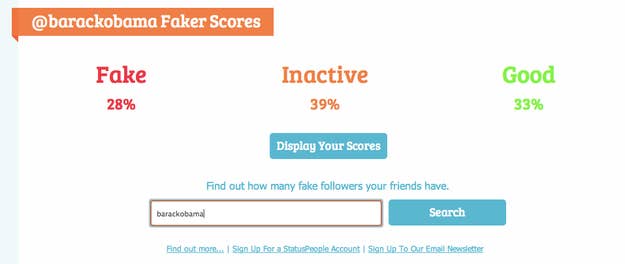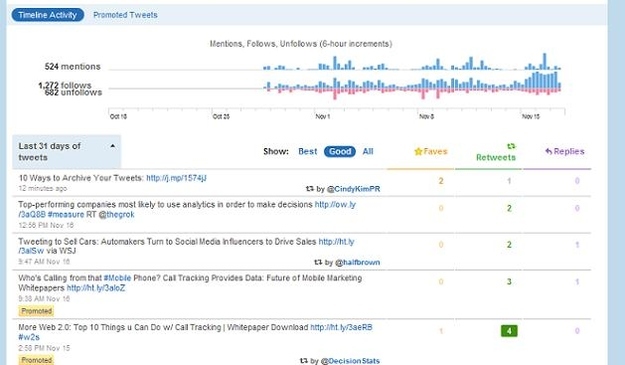
For the first time in its short history, Twitter seems stuck in a defensive pose: Its long-brewing battle with 3rd party developers is coming to pass; a strange fiasco in which a journalist appeared to get banned for criticizing one of its partners had people questioning its neutrality; a small but vocal group of startup types raised hundreds of thousands of dollars for a no-ad, for-pay Twitter clone. Now, a fresh line of attack: Twitter followers aren't all real.
A recent burst of stories about follower-selling websites like BuyTwitterFollow and FanMeNow and an account auditing tool Fake Follower Check have piled on: It isn't just Twitter's business decisions that should give you pause, they say, but the numbers at its core. From the New York Times:
[Fake Follower Check] examines Twitter relationships, said Rob Waller, a founder of StatusPeople. “Fake accounts tend to follow a lot of people but have few followers,” he said. “We then combine that with a few other metrics to confirm the account is fake.”
If accurate, the number of fake followers out there is surprising. According to the StatusPeople tool, 71 percent of Lady Gaga’s nearly 29 million followers are “fake” or “inactive.” So are 70 percent of President Obama’s nearly 19 million followers.
If you check your Twitter account you'll like get a surprising number, too: Only about 70% of my followers are "real," according to the tool.
But there are a few problems with the utility, not least of which is an apparent misunderstanding about how people use Twitter. First of all, at the time the above Times story was written, StatusPeople stated in its FAQ that the tool wouldn't be accurate on accounts with large followings (it has since increased its sample size from 500, which it says will give it better results). Secondly, one of the strange things about Twitter — not a secret, but not that widely known — is that nearly half of all active Twitter users don't Tweet. Asked about how Twitter identifies spam accounts, Twitter spokeperson Carolyn Penner explained: "Identifying [these] accounts on Twitter is complicated," she said. "Our process for doing so involves a wide range of data and signals only available internally and allows us to suspend accounts that are engaging in spam behavior while minimizing impact on legitimate accounts – including accounts that are used to consume content rather than share it."
The "only available internally" part is the crux: Twitter defines active accounts based on logins, not frequency of tweets (apps like StatusPeople's can't see logins). Twitter has just north of 140m "active" users that log in at least once a month. Of those 140m, about 40% only read tweets. Tweet-shy accounts, she said, "generally follow and engage with a lot of accounts" — a trait that StatusPeople's tool takes as a sign of fakeness. Throw in the fact that many of the largest accounts are on the Suggested User List, which helps skew their bases toward read-only users, and Obama's "70% fake" figure starts to make a lot more sense.
Of course, 40% of your users using just one half of your platform's capabilities might seem like a problem, but Twitter is fine with it. "This use of Twitter is awesome, and we actively encourage it by building engaging consumption experiences," Penner said. And if you look at what Twitter has been doing over the last year or so, you can see this 40% figure manifesting all over the place: email digests, Twitter cards, branded pages, content partnerships, the "Discover" tab. All these new features are bent on changing one part of the Twitter user math, making the experience of the silent 40% — consumption — more than half of what Twitter does.
There's also another idea lurking under the surface here, clues to which we can find in Twitter's oft-overlooked advertising tools. Some time ago, Twitter started deploying an in-house metrics tool for advertisers, which tracks follows and unfollows, of course, but more importantly retweets, "reach" and clickthroughs. (The number of people that actually follow the links in your tweets.) The advertiser analytics dashboard looked like this at launch:

It looks a bit different now, and since the advent of Twitter's URL shortener has reoriented itself around referral clicks over favs and retweets. The ability of your tweets to make people click on something is far more important to advertisers than the number of people that follow the accounts that they use; likewise, the number of people that actually engage with your tweets is more important than the number of people who could have theoretically seen them, based on your follow tally.
It's easy to imagine, then, a future in which follower counts are the second most important number on Twitter. The new most important number could be a metric we haven't seen yet; something like a — *shudder* — Klout score. Seriously.
